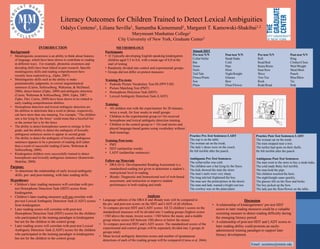This study examined the relationship between kindergarteners' ability to detect lexical ambiguities (words with multiple meanings) and later reading skills. 32 children were divided into experimental and control groups. The experimental group received training to identify homophones and ambiguous sentences, while the control group engaged in language activities without ambiguity. Pre- and post-training assessments measured ambiguity detection and reading levels. The study aims to determine if early ambiguity detection relates to later reading, and if training improves reading connections. Analyses will compare pre- and post-test ambiguity scores against standardized reading assessments for differences between experimental and control groups.
